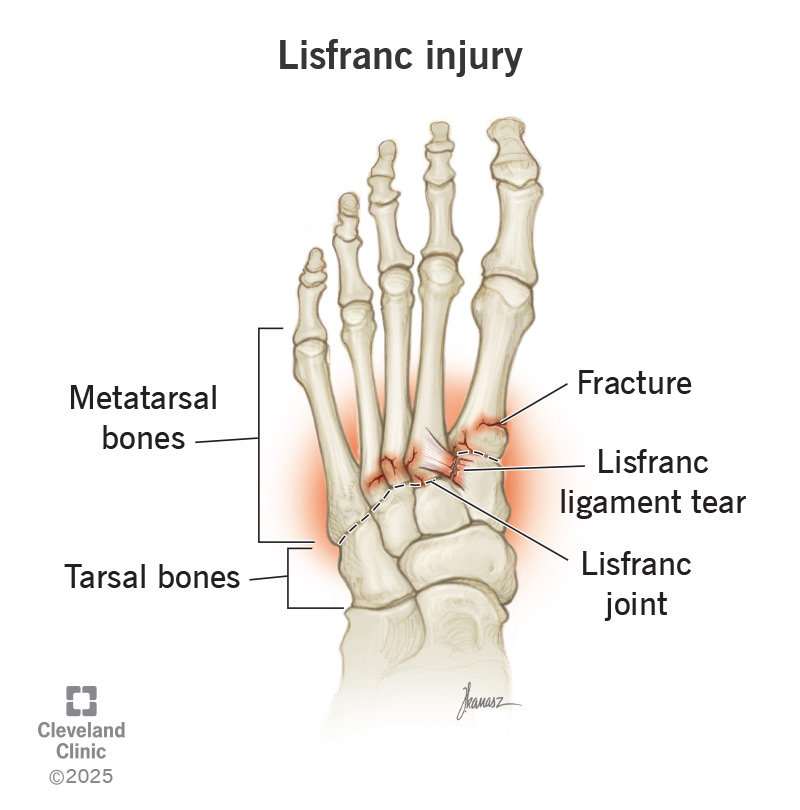A Lisfranc injury is anything that damages the Lisfranc joint at the top of your foot. Injuries can include dislocations, fractures and sprains. You’ll probably need to wear a boot or cast for several weeks. Severe injuries may require surgery. Your healthcare provider will tell you when it’s safe to resume physical activities or playing sports.
Advertisement
Cleveland Clinic is a non-profit academic medical center. Advertising on our site helps support our mission. We do not endorse non-Cleveland Clinic products or services. Policy

A Lisfranc injury is any damage to the Lisfranc joint on top of your foot. It’s where your metatarsal bones (the bridges to your toes) connect to the rest of your foot.
Advertisement
Cleveland Clinic is a non-profit academic medical center. Advertising on our site helps support our mission. We do not endorse non-Cleveland Clinic products or services. Policy
Because so many parts of your foot meet up in one place, the Lisfranc joint is very important. It’s just like a busy highway on-ramp or main intersection in a city: A lot depends on a relatively small area to make everything work correctly.
Visit a healthcare provider if it’s hard to move or use your foot — especially if you slipped, fell or know you hurt your foot recently.
Lisfranc injuries can affect the bones or ligaments in your joint. Depending on which part of your joint is damaged (and what causes the injury), you might experience a:
Lisfranc injuries cause symptoms near the top of your foot, including:
Lisfranc injuries are almost always the result of falls, slips or sports injuries.
Anything that makes your heel unexpectedly twist or spin while you’re stepping with weight on the ball of your foot can injure your Lisfranc joint. Athletes can injure their Lisfranc joints playing sports, but even a small stumble, or missing a stair or step, can cause an injury.
Advertisement
Traumas that crush the Lisfranc joint can also cause Lisfranc injuries. Examples include:
Anyone can experience a Lisfranc injury, but you might be more likely to if you:
If it’s not treated properly, a Lisfranc injury can lead to serious complications, including:
A healthcare provider will diagnose a Lisfranc injury with a physical exam and some imaging tests.
They’ll examine your foot and the area around it to check its shape and stability. Tell your provider what you were doing when you injured your foot or before you noticed symptoms.
After a physical exam, you’ll probably need at least one of a few imaging tests to take pictures of your foot, including:
The most common Lisfranc injury treatments include:
Visit a healthcare provider if you’re experiencing Lisfranc injury symptoms that don’t get better after a few days of rest and icing your foot. See a provider if you can’t put weight on your foot or walk normally.
Tell your provider if symptoms come back or get worse after you’ve started immobilization or had surgery.
How long it takes a Lisfranc injury to heal depends on which type you have and what caused it.
Remember: Everyone’s body heals at different speeds, so make sure to talk through your exact treatment timeline with your provider.
You might be able to walk with a Lisfranc injury. But you shouldn’t force yourself to use your foot if you’re in pain or have other symptoms. Continuing to use your foot can make a minor injury more severe and increase the chances that you need surgery.
It’ll probably be OK to walk in a boot or cast, but you should avoid running, jumping or any intense physical activities. Ask your provider which activities you should avoid while you recover.
Advertisement
You might have injured your Lisfranc joint by missing a step on the basement stairs or as part of a larger, scarier trauma, like a car accident. No matter what caused it, a healthcare provider should examine any unusual pain, swelling or bruising in your foot as soon as possible. Even if the injury ends up being something less serious, a Lisfranc injury — especially a fracture — can lead to lots of issues later on if you don’t get treatment right away.
Advertisement
From sudden injuries to chronic conditions, Cleveland Clinic’s orthopaedic providers can guide you through testing, treatment and beyond.

Last reviewed on 04/29/2025.
Learn more about the Health Library and our editorial process.